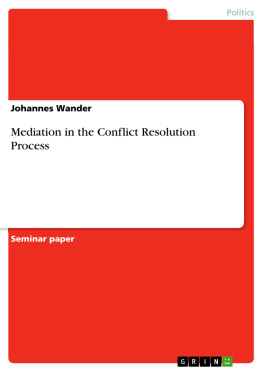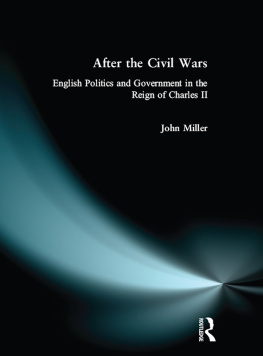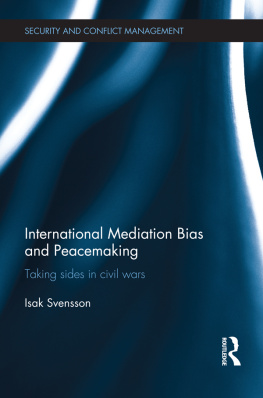Mediation of Civil Wars
About the Book and Author
As civil wars become forums for international conflicts and ideological rivalries, their containment and resolution is an increasingly important requisite for international peace. This book explores mediation as a means toward resolving such wars. Dr. Assefa argues that the sovereign sensitivities of incumbent governments, the risk of international legitimization of insurgents, and the need for reconciliation rather than mere containment demand special mediation efforts.
Using the Sudan civil war as a case study, the author reconstructs a successful mediation process through examination of confidential archival materials and through his extensive interviews with the mediators. The conditions that caused the Sudan civil war exist in many developing countries. Therefore this in-depth analysis provides an important insight in assessing and managing similar conflicts.
Hizkias Assefa is a consultant in conflict resolution and assistant professor in the Graduate Program of LaRoche College, Pittsburgh, specializing in management and international affairs. He is also coauthor of a forthcoming book entitled Extremist Groups and Conflict Resolution The MOVE Crisis in Philadelphia (1987).
Mediation of Civil Wars
Approaches and Strategies The Sudan Conflict
Hizkias Assefa
First published 1987 by Westview Press
Published 2018 by Routledge
52 Vanderbilt Avenue, New York, NY 10017
2 Park Square, Milton Park, Abingdon, Oxon OX14 4RN
Routledge is an imprint of the Taylor & Francis Group, an informa business
Copyright 1987 by Hizkias Assefa
All rights reserved. No part of this book may be reprinted or reproduced or utilised in any form or by any electronic, mechanical, or other means, now known or hereafter invented, including photocopying and recording, or in any information storage or retrieval system, without permission in writing from the publishers.
Notice:
Product or corporate names may be trademarks or registered trademarks, and are used only for identification and explanation without intent to infringe.
Library of Congress Cataloging-in-Publication Data
Assefa, Hizkias.
Mediation of civil wars.
(Westview special studies in peace, conflict,
and conflict resolution)
Bibliography: p.
Includes index.
1. Civil war. 2. Mediation, International.
3. SudanHistoryCivil War, 1955-1972. I. Title.
II. Series.
JX4541.A86 1987 341.5'2 86-15807
ISBN 13: 978-0-367-01133-8 (hbk)
To Gretchen, Sarah and Martha
This work would not have been possible without the cooperation and assistance of many people. I am infinitely grateful to the peacemakers in this study Canon Burgess Carr, whom I interviewed in Cambridge, Mass; Mr. Dwain Epps, in New York; Mrs. Barbara Haq, in London; Dr. Leoplodo Niilus, in Geneva; Mr. Kodwo Ankrah, in Kampala; and Mr. Samuel Bwogo, in Khartoum. They not only shared their time and their thoughts with me but also allowed me to enjoy their generosity and humanity which has left me with a sense of deep respect and inspiration.
I must also express my deep appreciation to Dr. Chris Mitchell, London; Dr. Louise Pirouet, Cambridge, England; Dr. Storrs McCall, Montreal; and Dr. Raphael Badal, Khartoum, for sharing their views and materials on the Sudan as well as for their hospitality. Thanks must go to Dr. Jerome Laulicht, who read an earlier draft of this manuscript and made a number of valuable suggestions; and to Dr. Richard Cottam, Dr. Daniel Cheever, Dr. David Gould, and Dr. Alex Weilenmann, all of Pittsburgh, from whom I benefitted a great deal in discussing this subject matter. My thanks to Joan Friedman who edited this manuscript with humor and enthusiasm.
I am very grateful to Mr. Ninan Koshy, Mr. Eric Weingartner, Mr. Ans Van der Bent and the Commission of the Churches for International Affairs of the World Council of Churches for their assistance and for facilitating my research in Geneva. Special thanks go to Mr. Dwain Epps for his contagious enthusiasm and support which helped keep my interest going during the first stages of this work when I had many doubts about the feasibility of the undertaking.
Then, I would like to thank my family. I cannot express enough gratitude to my wife, Gretchen Van Evera, who has been my discussant and source of support, without whose help, understanding, and encouragement this work might not have been a reality. I would like to express my deep appreciation for the help and encouragement I received from Mary Van Evera as well as the inspirations I have derived from her example. My special gratitude and affection also for my daughters: Sarah, who patiently tolerated the competition of this book for my attention, and Martha, who held back coming to this world until the week this book was completed. My thanks to my brother, Solomon, for helping in and enduring the final stages of the book's preparation. Finally, I would like to express my gratitude to my mother, Abeba Reda, who showed me the importance of reconciliation; and to my father, Assefa Wolde Gebriel, who instilled in me the values of perseverance and scholarship, and who, together, taught me that there is more than one side to an issue.
Hizkias Assefa
Part One
Theory of Mediation
Chapter 1
Introduction
Frank Hubbard, a nineteenth century caricaturist, remarked: "peace has its victories no less than war, but it does not have as many monuments to unveil." Almost a century later, the famous philosopher John Dewey, seemingly trying to convert this observation into a guide for behavior, suggested that "the only way to abolish war [is] to make peace heroic."
The need to make peace heroic has become even more imperative in the nuclear age since we live in a world where our preparations and skills in waging destructive conflicts have surpassed our efforts and skills in waging peace. This book pays tribute to the heroism of peacemaking by unveiling one monument that had been shrouded in mystery for some time and by identifying some approaches to the containment of conflict. It examines mediation as a method for the resolution of internationalized civil wars and analyzes the various conditions that facilitate its success. It then presents a case study where mediation was successfully utilized in an intractable internationalized civil war and examines the approach from the perspective of theory and practice.
There are several reasons why this study focuses on mediation and on civil wars. Before proceeding further, however, it is necessary to define these two concepts as they will be used in the subsequent analysis. It is difficult to define mediation precisely since it incorporates processes common to other third party interventions. Some authors have distinguished among five kinds of third party conflict resolution mechanisms: good offices, inquiry, mediation, arbitration, and are often used interchangeably with "mediation". In this study, the term mediation will include good offices and inquiry, and will be defined as an intervention in a conflict, by an actor not a party to the dispute, aimed at helping the parties resolve their conflict peacefully through negotiation and compromise.
The second concept calling for definition is the notion of civil war. It has been defined as a war fought between different geographical areas, political divisions, or ideological factions within the same country. Keeping these limitations in mind, the term internal war shall be used in the subsequent analysis as a more generic term that includes civil war.













